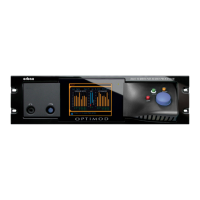OPTIMOD SURROUND PROCESSOR OPERATION
3-21
• You cannot give a user preset the same name as a factory preset. If the
name that you have selected duplicates the name of a factory preset, a
warning box will appear saying:
Factory presets cannot be overwritten.
• If the name you have selected duplicates the name of an existing user pre-
set, the 8685 warns you that you are about to overwrite that preset. An-
swer Y
ES if you wish to overwrite the preset and NO otherwise. If you an-
swer N
O, the 8685 will give you an opportunity to choose a new name for
the preset you are saving.
You can save user presets from the 8685 PC Remote application. (See
Using the 8685 PC Remote Control Software on page 3-65.) Please note
that
when you save presets from the PC Remote application, you save
them in the 8685’s memory (as if you had saved them from the 8685’s
front panel). The PC Remote application also allows you to archive pre-
sets to your computer’s hard drive (or other storage device) and to re-
store them. However, archiving a preset is not the same as saving it. Ar-
chived presets reside on a storage medium supported by your computer,
while saved presets reside in the 8685’s local non-volatile memory. You
cannot archive a preset until you have saved it. (See To back up user pre-
sets, system files, and automation files onto your computer’s hard drive
on page 3-68.)
Note that if, for some reason, you wish to save an unmodified preset (ei-
ther Factory or user) under a new name, you must temporarily make an
arbitrary edit to that preset in order to make the S
AVE PRESET button ap-
pear. After you have saved the preset, reverse the edit and save the pre-
set again.
About the Processing Structures
If you want to create your own User Presets, the following detailed discussion of the
processing structures is important to understand. If you only use Factory Presets or if
you only modify them with L
ESS-MORE, you may still find the material interesting
but you do not need to understand it to get excellent sound from the 8685. We
have carefully designed the 8685’s factory presets and most users will not need to go
beyond these.
In the 8685, a processing structure is a DSP configuration that operates as a com-
plete audio processing system. There are three basic structures: Two-Band, Five-
Band, and Pass-Through. To make transitions from one structure to the next as
smooth as possible, the DSP computes all processing structures simultaneously but
only one can be active in the foreground.
The surround and 2.0 processors are essentially independent and can use different
structures. For example, the surround processor could be running the five-band
structure while the 2.0 processor is running the two-band structure.

